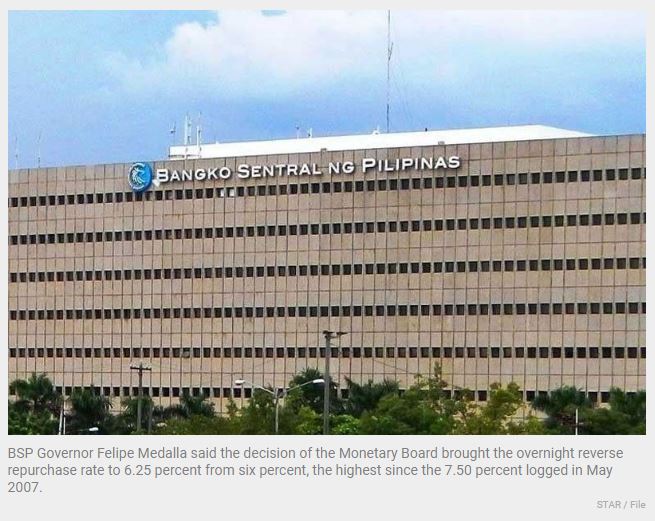Philippines: No surprises as BSP lifts rates by 25 bps
MANILA, Philippines — As expected, the Bangko Sentral ng Pilipinas (BSP) dialed down its tightening cycle as it delivered a smaller 25-basis-point increase amid easing, but persistent price pressures.
BSP Governor Felipe Medalla said the decision of the Monetary Board brought the overnight reverse repurchase rate to 6.25 percent from six percent, the highest since the 7.50 percent logged in May 2007.
The overnight deposit rate was also raised to 5.75 percent from 5.50 percent, while the overnight lending was increased to 6.75 from 6.50 percent.
“The Monetary Board’s decision was based on the sum of new information and its assessment of the effects of past policy actions, which warranted a continuation of monetary tightening to anchor inflation expectations,” Medalla said.
This was the same rate hike delivered by the US Federal Reserve earlier. (See story on B10)
Since it started raising interest rates in May last year, the BSP has so far increased key policy rates by 425 basis points (bps), making it the most aggressive central bank in the region.
With core inflation rising in February despite a modest decline in headline inflation, Medalla explained that further monetary policy action was deemed necessary to address broadening price impulses emanating from robust domestic demand and lingering supply-side constraints.
Headline inflation eased slightly to 8.6 percent in February from a 14-year high of 8.7 percent in January, but core inflation accelerated further to 7.8 percent from 7.4 percent.
Taking into consideration the inflation outturn last month, BSP Deputy Governor Francisco Dakila Jr. said the Monetary Board lowered its inflation forecasts to six percent from 6.1 percent for this year and to 2.9 percent from 3.1 percent for 2024.
Aside from the moderation of inflation in February, Dakila said monetary authorities also took into consideration the more challenging global growth outlook, as well as the cumulative impact of BSP’s previous policy rate adjustments.
Medalla is optimistic that inflation will likely go back to within the two to four percent target of the BSP by November or December this year.
According to the BSP Governor, “the inflation forecasts reflect the cumulative impact of the BSP’s policy rate adjustments and the slower growth outlook on both the domestic and external fronts.”
Moreover, the BSP chief pointed out that inflation expectations have increased slightly for this year, while those for 2024 and 2025 remain near the upper end of the target band.
According to Medalla, the central bank’s Monetary Board supports the creation of the Inter-agency Committee on Inflation and Market Outlook.
He said that the balance of risks to the inflation outlook for this year and next year also continue to tilt heavily towards the upside.
“The effect of supply shortages on domestic food prices remains a concern, while the potential impact of higher transport fares, increasing electricity rates, as well as above-average wage adjustments in 2023 point to the broader-based nature of price pressures,” he said.
On the downside, Medalla said the impact of a weaker-than-expected global economic recovery continues to be the primary factor that could dampen inflation.
“Given these considerations, the Monetary Board decided that follow-through monetary action would help ease persistent price pressures from here and abroad, as well as further realign inflation expectations with the target band over the policy horizon,” he said.
The BSP chief explained that further policy tightening would also preserve the buffer against external spillovers amid heightened uncertainty and volatility emanating from financial sector distress in advanced economies.
With the smaller rate hike, a pause from the tightening cycle is not being discounted.
“In the past, we were more or less sure that the next policy meeting would be an increase. Now, it clearly depends on the data. In the absence of new shocks, we think we are already moving in the right direction,” he said.
According to Medalla, there could be developments outside the Philippines that could significantly affect the decision of the Monetary Board.
Even as the BSP has assessed that the Philippine banking system is resilient to evolving market conditions, Medalla said authorities continue to keep a watchful eye over developments in the international banking industry.
Financial markets were spooked by the collapse of Silicon Valley Bank (SVB) and Signature Bank in the US, as well as the crisis faced by Credit Suisse in Europe.
Moving forward, he reassured the public that monetary authorities remain ready to respond further to inflation risks in line with the BSP’s data-dependent approach to ensuring price and financial stability.
Bank of the Philippine Islands lead economist Jun Neri said supply remains the major source of inflation.
With core and headline inflation still much higher than policy rates, Neri said the hike could manage the risk of further de-anchoring of expectations and sustained second round effects.
Michael Ricafort, chief economist at Rizal Commercial Banking Corp., said the BSP is likely to match the rate hikes of the US Fed in the coming months.
“Thus, the timeliness and size of any future local policy rate hikes would also be a function of the behavior of peso exchange rate, given its impact on import prices and overall inflation. So if the peso exchange rate is relatively stable, any future local policy rate adjustments would just match any future Fed rate moves in the near future,” Ricafort said.
Ricafort said relatively elevated inflation in recent months would also be a consideration on the size of any further local policy rate hikes, on top of any further Fed rate hike and the behavior of the peso exchange rate.
Source: https://www.philstar.com/business/2023/03/24/2254045/no-surprises-bsp-lifts-rates-25-bps


 Thailand
Thailand




